Buenos Aires tourist information.
Buenos Aires conjures up images of Tango dancers, gauchos, and romantic views. But this Cosmopolitan city offers so much more- great restaurants, Paris-inspired boulevards, enthralling neighborhoods, vibrant nightlife, and an intense spirit found in few other places. Whether shopping café con leche at its outdoor cafés, or strolling along the Río de la Plata, it quickly becomes apparent that Buenos Aires is a place like no other.
Buenos Aires, the ninth largest city in the world and the hub of the southern cone, is a sprawling megalopolis that rises from Río de la Plata and stretches more than 200 sq km (75sq mi) to the surroundings pampas, the fertile Argentine plains. It’s the political, economic, and cultural capital of Argentina the Gateway to the rest of the country.
Buenos Aires has 47 barrios (neighborhoods)- each with own character and its own story to tell. Most residents of Buenos Aires have lived in the same barrio for their entire lives and feel much more of an affinity to their neighborhood than to the city as a whole.
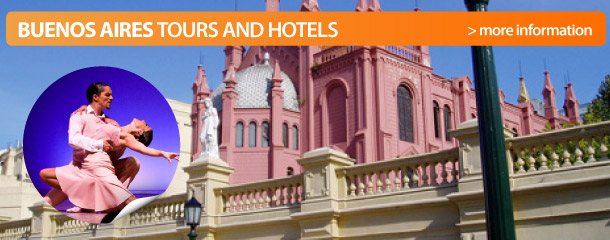
Unlike most South American cities, where the architecture principally reveals a strong Spanish colonial influence, Buenos Aires has a mix of architectural styles. Block after block of tidy high-rise apartment buildings are interspersed with 19th- century houses. Neighborhoods like Palermo, La Recoleta, and Belgrano feel more like Paris, with wide boulevards lined with palatial mansions, luxury high-rises, and spacious parks.
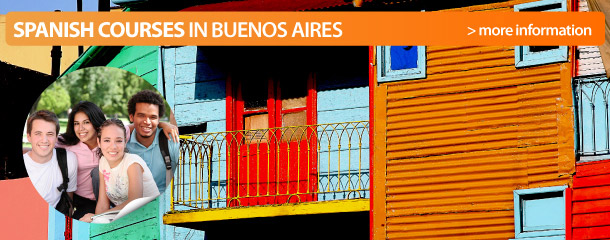
Flowers are sold at colorful corner kiosks, the smell of freshly baked bread wafts out of well-stocked bakeries, terrace cafés can be found on every block, and pedestrians can carry themselves with a fashionable reserve that is remarkably Parisian. In fact, Belgrano’s vast neighborhood park is an exact replica of one in Paris and its Church of the Immaculate Conception is modeled after Rome’s Pantheon. Even the Vatican Embassy on Avenida Alvear is a copy of the Jacquemart- André Museum in Paris. Other neighborhoods, such as San Telmo and La Boca, have a distinctly working-class Italian feel. Many have compared the Plaza de Mayo, principally the Avenida de mayo, to Budapest; and the Galerías Pacífico, a shopping mall in the center of the city, was built to look like Galleria Vittorio Emanuelle in Milan.
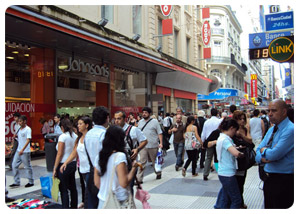 |
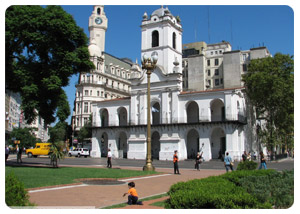 |
Buenos Aires locals are referred to as Porteños because many of them originally arrived by boat from Europe and started out in the city’s sport area, La Boca. Porteños are known as thinkers-they enjoy philosophical discussions and psychoanalysis (as proven by the large number of psychoanalysts per capita-in fact, the most of any city in the world). The citizens seem perpetually confused about their national identity-South American or European?-and are often concerned about how outsiders perceive them. Many are also deeply image-conscious, reflected in the lengths to which porteñas go to beautiful. With the men’s flashing stares and piquant compliments, they receive ample recognition for their efforts.
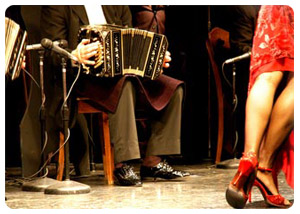 |
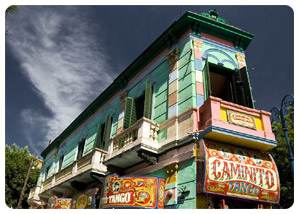 |
Buenos Aires has no Eiffel Tower, no internationally renowned museums, no must-see sights that clearly identify it as a world-class city. Rather, it provides a series of small interactions that have intense Latin spirit a flirtatious glance, a heartfelt chat, a juicy steak, beautiful tango which combine to create a vibrant and unforgettable urban experience.
Pleasure and Pastimes
Dining
Dining in Buenos Aires is an art, a passion, and a pastime. Whether at home or in restaurants, meals are events. Sobremesa (chatting after the meal) is just as important as the meal itself, and people linger at a table long after a meal is over. The staple is beef, which is usually cooked on the parrila (grill) or barbecue (asado). A typical meal consists of a steak accompanied by meat, French fries, salad and wine.
Lodging
Buenos Aires has a mix of hotels, inns, and apart-hotels (short-term rental apartments). Although the city isn’t known for its world-class facilities, it does have a few noteworthy establishments, including the Alvear Palace Hotel and The park Hyatt. Note that in summer (January and February, in particular), when most locals are on vacation and restaurants may be empty and stores closed, Buenos Aires hotels still charge high-season rates.
 |
 |
Exploring Buenos Aires
Buenos Aires is enormous and sprawling. You’re best off exploring one neighborhood at a time by foot and taking public transportation-bus or subte (subway). Streets are basically laid out ina grid, though a few streets transverse the grid at 45-degree angles; these are helpfully called diagonal. Avenidas are tow-way streets (at most hours of the day), while calles are generally one way. Each city block is exactly 100 meters long, and address are based on the building’s measured position on the street, not by street number (for instance, 180 Calle Florida is 100 meters, or one block, from 80 Calle Florida).
Great Itineraries
If you have 3 days
If you have only three days in Buenos Aires, you’ll have time to appreciate the city but at breakneck speed. Plan to spend a half day in each of the following areas: Plaza de Mayo, El Centro, La Boca, San Telmo, Palermo, and La Recoleta. If you’re in town in the middle of the week, try to stick to Palermo on Monday, since its attractions are open (whereas most museums are closed on Monday). Remember to schedule time for a siesta since, with only two nights in the city, you’ll want to spend one night out a club, bar, or performance and the other enjoying an evening of Tango.
If you have 5 days
With five days you can enjoy all of the sights described in the three day itinerary above. You’ll also have more time to explore La Recoleta or San Telmo and to explore Puerto Madero and Belgrano.
If you have 7-10 days
With more than a week in the Buenos Aires area , you can explore the city at a more relaxed pace, enjoying all the sights suggested in the three and five day itineraries above. You’ll also have time to get some areas that are more off the beaten path. On day six take a ferry trip across the river to picturesque Colonia, Uruguay, 50 minutes away arriving and departing by Hydrofoil and Ferry in Buenos Aires. On day seven take a trip to the suburbs and along the Río de la Plata on the Tren de la Costa, which departs from Tigre. With whatever time you have left, either spend it shopping and enjoying Buenos Aires, or make an excursion to the nearby towns of Lujan or La Plata.
 |
 |
When to tour in Buenos Aires
Timing a trip to Buenos Aires involves knowing what you’ll be in for in every season. The most important thing to remember is the most obvious- when it’s summer in the United States, it’s winter in Argentina, and vice versa. Winter in Argentina generally stretches from July to October, and summer is from December to March. Winters can be chilly and rainy, though the average temperature is always above freezing and it hasn’t showed in Buenos Aires in more than 100 years. Summer is very tropical, hot, and muggy, which is most likely to send you indoors to the air-conditioning (if you can find it) at midday but makes for wonderful, warm nights.
 |
 |
January is when most Porteños go on vacation , primarily to the Atlantic coast, which means that many business in Buenos Aires shut down and those that don’t close have reduced hours (even most banks, except American Express). In February most banks and government office open up again, but it’s still school vacation, so many stores remain closed until early March. Spring (October-early December) and fall (April-early June) are the best times to visit the city. It’s usually warm enough (over 50º F) to travel with just a light jacket. Theater and sports seasons are just starting up or having their grand finales, and Porteños are excited about the summer vacation they’ve just had or the one they’re about to take, so there’s an heightened energy in the air.
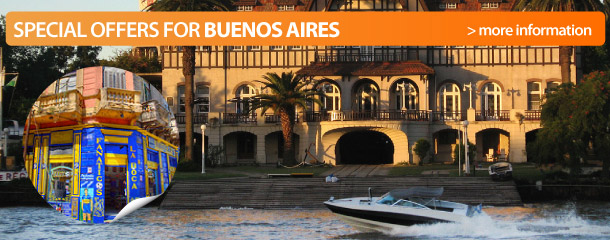
Neighborhoods of Buenos Aires
San Telmo
The appealing if a bit run-down neighborhood of San Telmo, halfway between midtown Buenos Aires and the south end of the city, is comparable to New York’s Greenwich Village. Its cobblestone streets are rich with early 19th – century colonial architecture and mansions, once inhabited by upper-class Spaniards. Over the years the mansions, were converted into multifamily housing for the immigrant families (particularly Italians) who began moving to this neighborhood in the late 19th century. For the past 20 years these old houses have been transformed into shops, art galleries, restaurants, and bars. The neighborhood is a cradle of Buenos Aires history and culture (including the tango) and folkloric traditions. Neighborhood and highlights include the Sunday flea market, the antiques shops along calle Defensa, and the tango bars that come to life nightly.
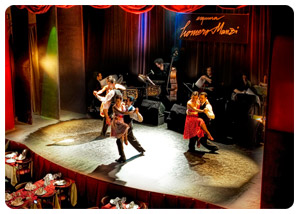 |
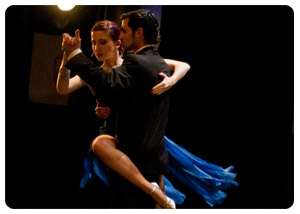 |
La Boca
The vibrant working-class neighborhood of La Boca is the southern neighbor of San Telmo. The first port of Buenos Aires, La Boca has seen many waves of immigrant populations pass through the borders. The most significant and lasting group were Italian immigrants from Genoa, who arrived between 1880 and 1930. Still known as the little Italy of Argentina, La Boca is the perfect place to find an authentic and inexpensive pizza or an impromptu tango lesson in the street.
 |
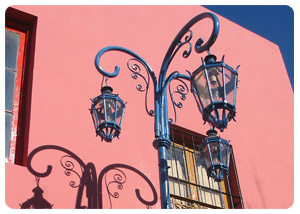 |
Plaza de Mayo
In a well-known scene in the musical Evita, Eva Perón stands on a picturesque balcony and waves to the Argentine masses assembled on a square below. She is supposed to be here, at the Plaza de Mayo. The political and historical center of Buenos Aires, the squares is home to the presidential palace and other governmental buildings. It has survived wars, floods, and political upheaval; on every corner you evidence of its history. Its attractions are principally dignitaries (as well as Argentina’s president ) at Sunday services, and some well-preserved remnants of Spanish colonial architecture.

 |
 |
El centro (downtown)
Your first glimpse of El Centro will most likely be en route from the airport. But be sure to return: Walking around the city center, dominated by a giant obelisk and the never-sleeping Avenida Corrientes, gives you a good feel for cosmopolitan Buenos Aires and its passionate Latin spirit. From the packed pedestrians-only Calle Florida and Calle Lavalle to the urban calm of Plaza San Martin, this is the social and business center of Argentina.
 |
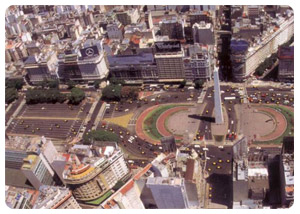 |
Puerto Madero
The revived old port has witnessed the proliferation of offices and fine restaurants in the past few years, making it the place to enjoy a coffee or dinner and a walk along the riverfront boardwalk. The port was originally constructed in 1890 as the European gateway to Argentina but spent most of the 20th century abandoned due to the creation of a new port (Puerto Nuevo). In August 1998 Puerto Madero was honored as the 47tharea to be designated a barrio of Buenos Aires, a tribute to its significant transformation.
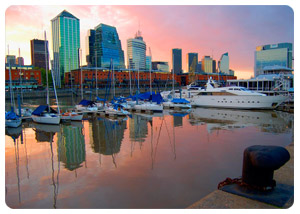 |
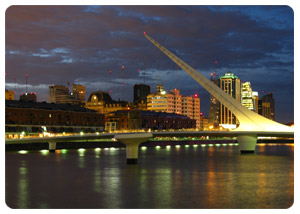 |
Plaza San Martin (San Martin Square)
Once a filed in a muddy suburb at the northern end of the city next to the steep riverbank, Plaza San Martín gradually evolved into its present state. At one time populated by vagrants and marginal members of the rough-and-tumble colonial society, the area around the square was transformed in the late1800s into the site of some of the most sumptuous town houses in Buenos Aires. The imposing bronze equestrian monument to General José de San Martin, created in 1862 by French artist Louis Daumas, dominates the park. French landscape architect Charles Thays designed the Plaza in the 19th century, using a mix of traditional local and exotic imported trees. To get a feel for real life in Buenos Aires, plan a visit to Plaza San Martin during a weekday lunch hour and relax in the crowed park while you watch business deals being hashed out and young lovers sneaking a kiss.
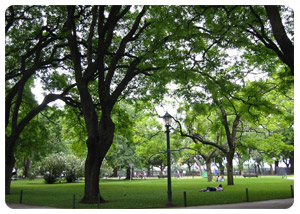 |
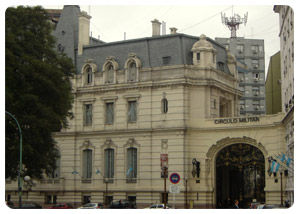 |
La Recoleta
La Recoleta, an elegant residential and shopping district northwest of downtown, is packed with boutiques, cafés, handsome old apartment buildings, plazas, museums, and cultural centers. Once a neighborhood where nobody wanted t olive, today La Recoleta is one of Buenos Aires’s most sought-after district, surpassed in trendiness only recently by Puerto Madero. About 25 years ago a few brave entrepreneurs decided to take advantage of its low rents, opening some of the city’s best restaurants. Upscale, European-style boutiques followed, and then members of Argentina’s high society began moving here as well. Part of La Recoleta is now closed to traffic, and street-side cafés dot the area. Here people-watching is a highly developed art form, practiced predominantly by the perennially tanned and trim.
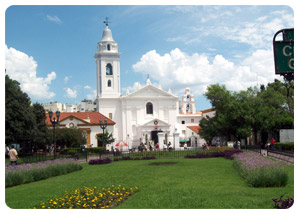 |
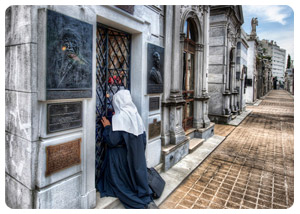 |
Palermo
Palermo, a district of parks and lakes surrounded by quiet streets and elegant mansions, offers a peaceful escape from the rush of downtown Buenos Aires. Families flock to the parks on weekends to picnic, suntan, bicycle, rollerblade, and jog. Palermo is also home to the Polo field and the hore racetrack and i thus the center of horse cultura in Buenos Aires. One of the city’s larget barrios, Palermo has many distinct sub-neighborhoods: Palermo Viejo has classic Spanish-style architecture; Las Cañitas is a trendy place to go out at night; and Palermo Chico is an elegant residential area. Some of the most expensive real state in Argentina is found along Avenida Del Libretador, which cuts Palermo down the middle. But don’t let Palermo’s daytime tranquillity fool you: At night it gives way to some of the city’s best nightlife, as neighorhood bars and discos rock to latin beats.
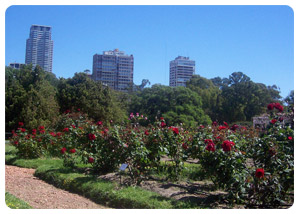 |
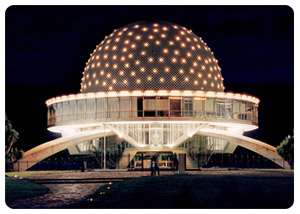 |
Belgrano
Primarly a residential area, the fashionable, quiet district of Belgrano is home to beautiful mansions, luxuary high-rises, and well-kept coblestone streets leading off bustling Avenida Cabildo.
The Art of Tango
A mixture of passion, sensuality, nostalgia, and melancholy, the tango is the dance of Argentina and Buenos Aires is its capital. Every child learns it, every couple knows it. You can experience the cultura of tango everywhere in Buenos Aires: at a show at the world-famous Casablanca, in a spontaneous outburst on Calle Florida, at a glitzy nightclub, or at a neighborhood spot in San Telmo. Opening days and times of Tango halls regularly change, so call to verify before you arrive. If you’d prefer to bask in the history of dance, retrace the footsteps of Carlos Gardel, the tango’s great hero (he died in a plane crash in 1935 at the age of 40), in the Mercado del Abasto neighborhood and then the visit his grave at the Chacarita Cemetery.
|



